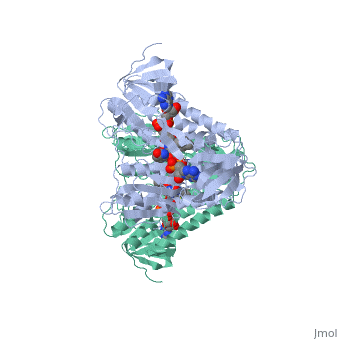Dihydrolipoamide dehydrogenase
From Proteopedia
(Difference between revisions)
| Line 9: | Line 9: | ||
==Mechanism== | ==Mechanism== | ||
The redox reaction occurs through the influence of <scene name='Nicholas_Rockefeller_Sandbox/Cys43cys48/3'>Cys 43 and Cys 48</scene>, between which there is a disulfide bond within a distorted alpha helix. This redox active disulfide bond becomes reduced in order to reoxidize the E2 enzyme of the multienzyme complex.‘<ref>Voet, Donald et al. 2008. Fundamentals of Biochemistry. 3rd ed. pp.570-575</ref>’ E2 donates protons and electrons to E3 in order to complete its catalytic cycle. The E3 enzyme’s flavin ring (FAD) funnels electrons from the disulfide bond to itself, <scene name='Nicholas_Rockefeller_Sandbox/Fadnad/1'>then binds to NAD+ and donates electrons</scene>, reoxidizing the E3, and leaving it ready for the beginning of its catalytic cycle again. | The redox reaction occurs through the influence of <scene name='Nicholas_Rockefeller_Sandbox/Cys43cys48/3'>Cys 43 and Cys 48</scene>, between which there is a disulfide bond within a distorted alpha helix. This redox active disulfide bond becomes reduced in order to reoxidize the E2 enzyme of the multienzyme complex.‘<ref>Voet, Donald et al. 2008. Fundamentals of Biochemistry. 3rd ed. pp.570-575</ref>’ E2 donates protons and electrons to E3 in order to complete its catalytic cycle. The E3 enzyme’s flavin ring (FAD) funnels electrons from the disulfide bond to itself, <scene name='Nicholas_Rockefeller_Sandbox/Fadnad/1'>then binds to NAD+ and donates electrons</scene>, reoxidizing the E3, and leaving it ready for the beginning of its catalytic cycle again. | ||
| + | |||
| + | ==Disease== | ||
| + | DLD deficiency is a rare metabolic disorder causing neurological or liver impairment<ref>PMID:23478190</ref>. | ||
==Regulation== | ==Regulation== | ||
Revision as of 07:55, 10 June 2019
| |||||||||||
3D structures of dihydrolipoamide dehydrogenase
Updated on 10-June-2019
References
- ↑ Brautigam CA, Wynn RM, Chuang JL, Machius M, Tomchick DR, Chuang DT. Structural insight into interactions between dihydrolipoamide dehydrogenase (E3) and E3 binding protein of human pyruvate dehydrogenase complex. Structure. 2006 Mar;14(3):611-21. Epub 2006 Jan 26. PMID:16442803 doi:10.1016/j.str.2006.01.001
- ↑ Voet, Donald et al. 2008. Fundamentals of Biochemistry. 3rd ed. pp.570-575
- ↑ Brassier A, Ottolenghi C, Boutron A, Bertrand AM, Valmary-Degano S, Cervoni JP, Chretien D, Arnoux JB, Hubert L, Rabier D, Lacaille F, de Keyzer Y, Di Martino V, de Lonlay P. Dihydrolipoamide dehydrogenase deficiency: a still overlooked cause of recurrent acute liver failure and Reye-like syndrome. Mol Genet Metab. 2013 May;109(1):28-32. doi: 10.1016/j.ymgme.2013.01.017. Epub, 2013 Feb 1. PMID:23478190 doi:http://dx.doi.org/10.1016/j.ymgme.2013.01.017
- ↑ Voet, Donald et al. 2008. Fundamentals of Biochemistry. 3rd ed. p.585
Proteopedia Page Contributors and Editors (what is this?)
Michal Harel, Nicholas Rockefeller, Alexander Berchansky, David Canner, Shane Michael Evans, Jaime Prilusky

